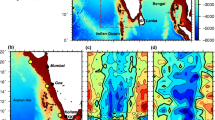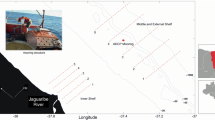Abstract
Direct current measurements by a shipboard and bottom-mounted acoustic Doppler current profiler and concurrent hydrographic observations with a CTD were conducted off southeastern Hokkaido, Japan, between January and May 2005 to reveal temporal variations in the current structure and volume transport of the Coastal Oyashio (CO). The CO, which has a baroclinic jet structure with southwestward speeds exceeding 90 cm s−1 and a width of 7–8 km, was associated with a surface-to-bottom density front and was formed on the offshore side of the shelf break. The volume transport of CO (T CO) was estimated by integrating the fluxes of lower-density water that was trapped against the coast along the density front represented by the 26.2 σ θ isopycnal line. This transport decreased monotonously from 0.79 Sv (1 Sv = 106 m3 s−1) in January to 0.21 Sv in March and subsequently to 0.12 Sv in May, possibly due to the decay of the East Sakhalin Current Water in the Okhotsk Sea. Accompanied by a decrease in T CO, the location of the jet structure associated with the density front moved toward the coast while the maximum speed of the jet decreased and the tilt of the front became more horizontal. Consequently, more saline offshore Oyashio water flowed into the deep part of the shelf area, and the current structure altered from relatively barotropic in winter to baroclinic in spring. This study is the first to estimate the observed volume transport of the CO from direct current measurements.













Similar content being viewed by others
References
Chapman DC (2000) Boundary layer control of buoyant coastal currents and the establishment of a shelf break front. J Phys Oceanogr 30:2941–2955
Chapman DC, Lentz SJ (1994) Trapping of a coastal density front by the bottom boundary layer. J Phys Oceanogr 24:1464–1479
Hanawa K, Mitsudera H (1985) On the data processing of daily mean values of oceanographic data: note on the daily mean sea-level data. Bull Coast Oceanogr 23:79–87 (In Japanese)
Hanawa K, Mitsudera H (1987) Variations of water system distribution in the Sanriku coast area. J Oceanogr Soc Jpn 42:435–446
Isoda Y, Kuroda H, Myousyo T, Honda S (2003) Hydrographic feature of Coastal Oyashio and its seasonal variation. Bull Coast Oceanogr 41:5–12 (In Japanese with English abstract)
Itoh M, Ohshima KI (2000) Seasonal variations of water masses and sea level in the southwestern part of the Okhotsk Sea. J Oceanogr 56:643–654
Joyce TM (1989) On in situ “calibration” of shipboard ADCPs. J Atmos Ocean Technol 6:169–172
Katoh O (1988) Measurement of residual current using the Doppler sonar. Bull Seikai Reg Fish Res Lab 66:59–67 (in Japanese with English abstract)
Kono T, Foreman M, Chandler P, Kashiwai M (2004) Coastal Oyashio south of Hokkaido, Japan. J Phys Oceanogr 34:1477–1494
Kusaka A, Ono T, Azumaya T, Kasai H, Oguma S, Kawasaki Y, Hirakawa K (2009) Seasonal variations of oceanographic conditions in the continental shelf area off the eastern Pacific coast of Hokkaido, Japan. Oceanogr Jpn 18(2):135–156 (In Japanese with English abstract)
Kusaka A, Azumaya T, Kawasaki Y (2013) Monthly variations of hydrographic structures and water mass distribution off the Doto area, Japan. J Oceanogr 69(3):295–312
Murakami T (1984) Intrusion of Coastal Oyashio water into the southern part of Hokkaido. Kaiyo Mon 17:697–701 (In Japanese)
Nakayama Y, Kuma K, Fujita S, Sugie K, Ikeda T (2010) Temporal variability and bioavailability of iron and other nutrients during the spring phytoplankton bloom in the Oyashio region. Deep Sea Res 57:1618–1629
Ogasawara J (1987) Oyashio and Doto coastal current. Kaiyo Mon 19:21–25 (In Japanese)
Oguma S, Ono T, Kusaka A, Kasai H, Kawasaki Y, Azumaya T (2008) Isotopic tracers for water masses in the coastal region of eastern Hokkaido. J Oceanogr 64:529–539
Ohtani K (1971) Studies on the change of the hydrographic conditions in the Funka Bay. II. Characteristics of the waters occupying the Funka Bay. Bull Fac Fish Hokkaido Univ 22:58–66 (in Japanese with English abstract)
Ohtani K (1989) The role of the Sea of Okhotsk on the formation of the Oyashio water. Umi Sora 65(2):63–83 (in Japanese with English abstract)
Okuda K (1986) Occurrence of extremely low temperature in the coastal region of the Tohoku area associated with inter-annual variations of the Oyashio. Bull Tohoku Reg Fish Lab 48:87–96 (in Japanese with English abstract)
Rosa AL, Isoda Y, Uehara K, Aiki T (2007) Seasonal variations of water system distribution and flow patterns in the southern sea area of Hokkaido, Japan. J Oceanogr 63:573–588
Sakamoto K, Tsujino K, Nishikawa S, Nakano H, Motoi T (2010) Dynamics of the Coastal Oyashio and its seasonal variation in a high-resolution Western North Pacific Ocean Model. J Phys Oceanogr 40:1283–1301
Shimizu M, Isoda Y (1999) Flow structure of the Coastal Oyashio on the shelf area of Hidaka Bay. Bull Coast Oceanogr 36(2):163–169 (In Japanese with English abstract)
Watanabe K (1963) On the reinforcement of the East Sakhalin Current preceding to the sea ice season off the coast of Hokkaido. Oceanogr Mag 14:117–130
Acknowledgments
We would like to acknowledge the assistance of the captain and crew of the R/V Hokko Maru of the Hokkaido National Fisheries Research Institute, Fisheries Research Agency for their help with the deployment and recovery of the bottom-mounted ADCP. We also greatly appreciate Dr. T. Tozuka and the anonymous reviewers for reviewing our manuscript and giving useful comments. This work was financially partly supported by the Ministry of Agriculture, Forestry and Fisheries, Japan through a research project entitled “Development of mitigation technologies to climate change in the agriculture sector”.
Author information
Authors and Affiliations
Corresponding author
Appendix: F-COW
Appendix: F-COW
In the time series for A01 (and P21), warmer and less saline water (T > 2 °C, S < 33) was observed around December 2004 and January 2005 (this period is denoted by thick arrows in Fig. 9). This water cannot be judged to be the COW because its temperature was higher than the upper limit (2 °C) of the COW temperature index. Such less saline and warmer water was also observed on the coastal side of A02 on January 11 (upper and middle panels in Fig. 3a). CTD data between 10 and 100 m at A01 and A02 in January and March were plotted on the T–S plane (Fig. 14). In this study, the less saline and warmer water observed at A01 and A02 on January 11 is called as the Forerunner COW (F-COW) because it was in the process of being modified to the COW. However, note that the F-COW and Surface COW (S-COW; Rosa et al. 2007) cannot be distinguished by a T–S analysis alone, because both water mass characteristics overlap in the T–S plane (Fig. 14).
A temperature–salinity diagram for data obtained at A01 (gray) and A02 (black) in January and March 2005. CTD data between 10 and 100 m at each station are plotted. COW, F-COW, S-COW, M-SWCW, and OW denote the regions of Coastal Oyashio water (T < 2 °C and S < 33; Ohtani 1971), Forerunner COW (T > 2 °C and S < 33), Surface COW (T > 2 °C and S < 33; Rosa et al. 2007), Modified Soya Warm Current Water (T > 7 °C and 33 < S < 33.7; Oguma et al. 2008), and Oyashio water (T < 7 °C, 33 < S < 33.7 and σ θ < 26.7; Hanawa and Mitsudera 1987), respectively. Curves denote isopycnals at 25.0, 26.0, and 26.7
Rights and permissions
About this article
Cite this article
Kusaka, A., Shimizu, Y., Sato, T. et al. Temporal variations in the current structure and volume transport of the Coastal Oyashio revealed by direct current measurement. J Oceanogr 72, 601–615 (2016). https://doi.org/10.1007/s10872-016-0356-2
Received:
Revised:
Accepted:
Published:
Issue Date:
DOI: https://doi.org/10.1007/s10872-016-0356-2





